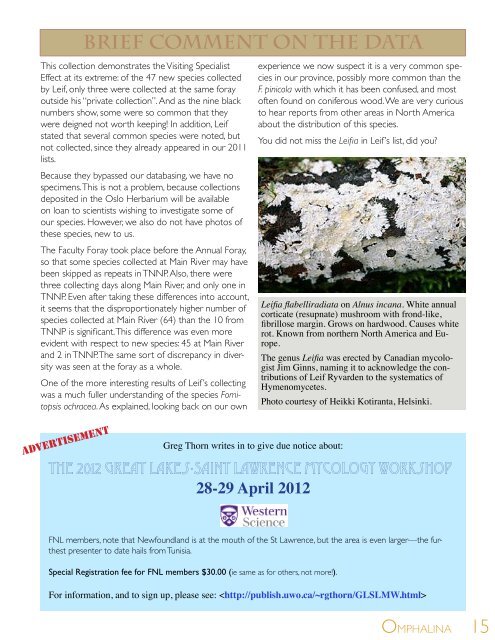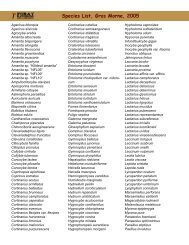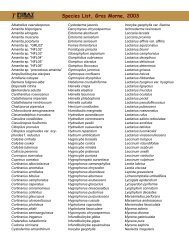Newsletter of - Foray Newfoundland and Labrador
Newsletter of - Foray Newfoundland and Labrador
Newsletter of - Foray Newfoundland and Labrador
Create successful ePaper yourself
Turn your PDF publications into a flip-book with our unique Google optimized e-Paper software.
ief comment on the data<br />
This collection demonstrates the Visiting Specialist<br />
Effect at its extreme: <strong>of</strong> the 47 new species collected<br />
by Leif, only three were collected at the same foray<br />
outside his “private collection”. And as the nine black<br />
numbers show, some were so common that they<br />
were deigned not worth keeping! In addition, Leif<br />
stated that several common species were noted, but<br />
not collected, since they already appeared in our 2011<br />
lists.<br />
Because they bypassed our databasing, we have no<br />
specimens. This is not a problem, because collections<br />
deposited in the Oslo Herbarium will be available<br />
on loan to scientists wishing to investigate some <strong>of</strong><br />
our species. However, we also do not have photos <strong>of</strong><br />
these species, new to us.<br />
The Faculty <strong>Foray</strong> took place before the Annual <strong>Foray</strong>,<br />
so that some species collected at Main River may have<br />
been skipped as repeats in TNNP. Also, there were<br />
three collecting days along Main River, <strong>and</strong> only one in<br />
TNNP. Even after taking these differences into account,<br />
it seems that the disproportionately higher number <strong>of</strong><br />
species collected at Main River (64) than the 10 from<br />
TNNP is signifi cant. This difference was even more<br />
evident with respect to new species: 45 at Main River<br />
<strong>and</strong> 2 in TNNP. The same sort <strong>of</strong> discrepancy in diversity<br />
was seen at the foray as a whole.<br />
One <strong>of</strong> the more interesting results <strong>of</strong> Leif’s collecting<br />
was a much fuller underst<strong>and</strong>ing <strong>of</strong> the species Fomitopsis<br />
ochracea. As explained, looking back on our own<br />
advertisement<br />
Greg Thorn writes in to give due notice about:<br />
experience we now suspect it is a very common species<br />
in our province, possibly more common than the<br />
F. pinicola with which it has been confused, <strong>and</strong> most<br />
<strong>of</strong>ten found on coniferous wood. We are very curious<br />
to hear reports from other areas in North America<br />
about the distribution <strong>of</strong> this species.<br />
You did not miss the Leifi a in Leif’s list, did you?<br />
Leifi a fl abelliradiata on Alnus incana. White annual<br />
corticate (resupnate) mushroom with frond-like,<br />
fi brillose margin. Grows on hardwood. Causes white<br />
rot. Known from northern North America <strong>and</strong> Europe.<br />
The genus Leifi a was erected by Canadian mycologist<br />
Jim Ginns, naming it to acknowledge the contributions<br />
<strong>of</strong> Leif Ryvarden to the systematics <strong>of</strong><br />
Hymenomycetes.<br />
Photo courtesy <strong>of</strong> Heikki Kotiranta, Helsinki.<br />
The 2012 Great Lakes-Saint Lawrence Mycology Workshop<br />
28-29 April 2012<br />
FNL members, note that <strong>Newfoundl<strong>and</strong></strong> is at the mouth <strong>of</strong> the St Lawrence, but the area is even larger—the furthest<br />
presenter to date hails from Tunisia.<br />
Special Registration fee for FNL members $30.00 (ie same as for others, not more!).<br />
For information, <strong>and</strong> to sign up, please see: <br />
OMPHALINA 15





